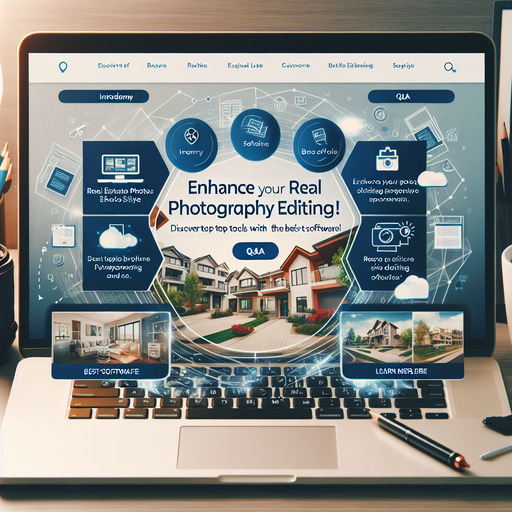
-
Table of Contents
Enhance your real estate photos with the best editing software! Discover top tools and techniques now. Learn more here.
Introduction
Real estate photography editing is a crucial aspect of presenting properties in the best possible light, enhancing their appeal to potential buyers and renters. High-quality images can significantly impact the perceived value of a property, making it essential for real estate professionals to utilize effective editing software. The best software for real estate photography editing includes Adobe Photoshop, known for its comprehensive tools and versatility; Adobe Lightroom, favored for its user-friendly interface and powerful editing capabilities; and specialized programs like Photomatix for HDR imaging, which helps in capturing the full dynamic range of a scene. Other notable mentions are GIMP, a free alternative with robust features, and Aurora HDR, which excels in high dynamic range processing. These tools offer a range of functionalities from basic adjustments to advanced retouching, ensuring that real estate photos are polished, professional, and visually compelling.
Real Estate Photography Editing: Best Software to Use
Real estate photography plays a crucial role in the marketing and sale of properties. High-quality images can significantly enhance a listing’s appeal, attracting potential buyers and expediting the sales process. However, capturing the perfect shot is only half the battle; the other half lies in the editing process. Selecting the right software for real estate photography editing can make a substantial difference in the final output. Several software options stand out in this domain, each offering unique features and capabilities that cater to different needs and skill levels.
Adobe Lightroom is often the go-to choice for many professional photographers. Its robust set of tools allows for comprehensive adjustments, from basic exposure and color correction to more advanced features like lens correction and gradient filters. Lightroom’s non-destructive editing process ensures that the original image remains untouched, providing flexibility and peace of mind. Additionally, its user-friendly interface and extensive library management capabilities make it easier to organize and edit large volumes of photos, a common requirement in real estate photography.
Transitioning to another powerful tool, Adobe Photoshop offers unparalleled control over image manipulation. While Lightroom excels in batch processing and basic adjustments, Photoshop is the software of choice for more intricate edits. Whether it’s removing unwanted objects, blending multiple exposures, or adding virtual staging elements, Photoshop provides the precision and versatility needed for high-end real estate photography. Its layer-based editing system allows for complex compositions and detailed retouching, making it an indispensable tool for those looking to achieve perfection in their images.
For those seeking a more budget-friendly option, GIMP (GNU Image Manipulation Program) serves as a viable alternative. As an open-source software, GIMP offers many of the same features found in Photoshop, including layers, masks, and advanced selection tools. While it may have a steeper learning curve and a less polished interface, GIMP’s capabilities are impressive, especially considering it is free to use. This makes it an excellent choice for beginners or those working with limited resources.
Another noteworthy mention is Skylum’s Luminar. Known for its AI-powered editing tools, Luminar simplifies the editing process without compromising on quality. Features like AI Sky Replacement and AI Structure allow for quick and effective enhancements, making it particularly useful for real estate photographers who need to process images rapidly. Luminar’s intuitive interface and one-click presets also make it accessible to users of all skill levels, providing a balance between ease of use and powerful editing capabilities.
Capture One is another professional-grade software that deserves attention. Renowned for its exceptional color grading tools and tethered shooting capabilities, Capture One is favored by many commercial photographers. Its advanced color editor allows for precise adjustments, ensuring that the colors in your real estate photos are both accurate and vibrant. Additionally, Capture One’s customizable workspace and robust file management system make it a strong contender for those who require a high level of control and organization in their editing workflow.
In conclusion, the choice of software for real estate photography editing largely depends on individual needs and preferences. Adobe Lightroom and Photoshop offer comprehensive solutions for both basic and advanced editing tasks, while GIMP provides a cost-effective alternative with substantial capabilities. Luminar’s AI-driven tools and user-friendly interface make it an attractive option for quick edits, and Capture One’s superior color grading and file management features cater to professional requirements. By understanding the strengths and limitations of each software, photographers can make informed decisions that enhance their workflow and elevate the quality of their real estate images.
Q&A
1. **What is the best software to use for real estate photography editing?**
– **Adobe Lightroom**: Known for its powerful photo editing capabilities and user-friendly interface.
– **Adobe Photoshop**: Offers advanced editing tools for more detailed and complex edits.
– **Aurora HDR**: Ideal for creating high dynamic range (HDR) images, which are popular in real estate photography.
– **Photomatix Pro**: Another excellent option for HDR photography, providing various presets and customization options.
– **GIMP**: A free, open-source alternative to Photoshop with a wide range of editing tools.
– **Capture One**: Known for its superior color grading and tethered shooting capabilities.
– **Affinity Photo**: A cost-effective alternative to Photoshop with robust editing features.